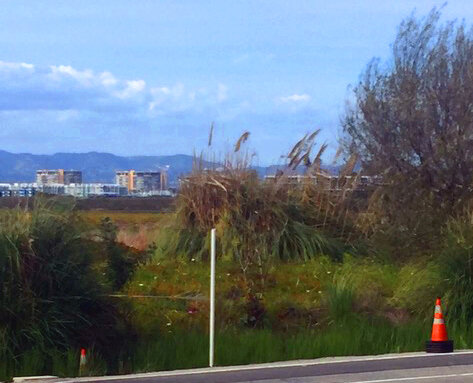Roadside wonder! A roadside tadpole pond
By Cindy Hardin, Outdoor Education Director, Los Angeles
Audubon Society
March 30, 2020
Our physical boundaries continue to diminish during these unique times. Currently, all residents of California have been ordered to stay safer and closer to home. Consequently, people are being urged and compelled to be in their own neighborhoods, and explore all that is nearby.
Due to the long ago design choices that made Los Angeles a kind of suburban city, there is much nature to be found all over town. Tree lined streets, courtyard style apartments, the occasional urban park and private back yards mean lots of habitat is available for birds, butterflies, insects and larger animals, like racoons, possums and coyotes. The ability of these creatures to adapt to and thrive within the city limits means that there is ample opportunity to be an observer of nature on a very local level. All one has to do is to look, and then look even closer. The rewards of this careful observation can be tremendous.
I have the good fortune to live in a neighborhood that is adjacent to 640 acres of open space: the Ballona Wetlands Ecological Reserve. The Westchester Bluffs and their small canyons above Ballona provide a natural funnel for rainwater, creating seasonal ponds below, full of life. The unexpected “March Miracle” of precipitation, which followed a January and February that were some of the driest on record, has reinvigorated these ponds, and proof of life can not only be seen, but also heard! I am talking about the robust presence of the Pacific Chorus Frog. As one goes along the western end of Culver Boulevard in the evenings, their song is almost cacophonous. The males are singing their hearts out, hoping to catch the attention of the females.
Although this ponding does not look like large woodland ponds, the water features are no less viable. And they are producing in easily overlooked locations. As drivers speed down Culver Blvd. in a car, they pass accumulation of water that to the casual observer looks like nothing more than a rain swollen gutter. But if one were to visit this site on foot, with a little careful viewing they would see a nursery! That’s right-this “gutter” actually sits upon a freshwater spring. During seasonal rains, sufficient levels of water are present long enough to support Pacific Chorus Frog tadpoles, the end product of all that frogsong. The Pacific Chorus Frog is well adapted to face the challenge of living in our Mediterranean Climate and its less than dependable amount of seasonal rainfall. Although their tadpoles ideally need at least five months in the water before metamorphosis into adulthood, if they sense the pond is drying up, they can accelerate their maturation. This is an essential survival tool!
The persistence of the tadpole and nature — it is all around us!
In addition, the tadpoles of the introduced American Bullfrog, a voracious predator of tadpoles, frogs and many other things, requires at least six months, and even years in colder climates, to mature. As a result, Bullfrogs prefer to lay their eggs in ponds that have water year round. The ephemeral nature of the breeding ponds used by the Chorus Frog helps to separate their young from at least one predator!
The pond on Culver (I refuse to call it a gutter!) is a wonder to behold. It is fringed by cattails, a native Mulefat, also called Seep Willow, shades one edge, worm species squiggle through the water and cling to algae covered reeds, small water insects called ostracods busily glide across the sediment, and tadpoles in different stages of development abound. Some are already sprouting legs, while others are so small they look like tiny black pebbles with tails. The variation in size and life stage is a good sign-an indication that breeding is ongoing, and waves of new frogs will soon be adding to the population.
This little pond is extremely present and yet is in large part ignored by most passerby. It is the epitome of an argument for closer exploration of things that might easily be overlooked. As most of us have been forced into a mandatory slowdown, there is no better time to look and then look closer at all that is around us. The constancy of nature can be quite comforting in a period of life that can be quite inconsistent. Let’s all get out and take a look!



